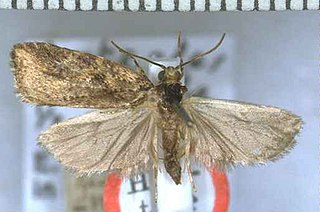Xyroptila peltastes is a moth of the family Pterophoridae. It is found in Australia.

Bucculatrix ulmella is a moth of the family Bucculatricidae. It is found in most of Europe, except the Iberian Peninsula, Slovenia and Bulgaria. It was first described in 1848 by Philipp Christoph Zeller.
Syllepte trachelota is a moth in the family Crambidae described by Alfred Jefferis Turner in 1913. It is found in Australia, where it has been recorded from Queensland.
Dichomeris carycina is a moth in the family Gelechiidae. It was described by Edward Meyrick in 1914. It is found in Guyana and Brazil.
Dichomeris caryophragma is a moth in the family Gelechiidae. It was described by Edward Meyrick in 1923. It is found in Guyana and Pará, Brazil.
Pseudotelphusa fuscopunctella is a moth of the family Gelechiidae. It is found in North America, where it has been recorded from Arkansas, Florida, Georgia, Illinois, Indiana, Kentucky, Maine, Mississippi, Pennsylvania, New Jersey, South Carolina and West Virginia.
Aristotelia dasypoda is a moth of the family Gelechiidae. It was described by Walsingham in 1910. It is found in Mexico (Tabasco) and Jamaica.
Aristotelia pyrodercia is a moth of the family Gelechiidae. It was described by Walsingham in 1910. It is found in Mexico (Guerrero).
Aristotelia squamigera is a moth of the family Gelechiidae. It was described by Walsingham in 1909. It is found in Mexico (Guerrero).
Monochroa agatha is a moth of the family Gelechiidae. It was described by Edward Meyrick in 1918. It is found in Assam, India.
Taygete sylvicolella is a moth in the family Autostichidae. It was described by August Busck in 1903. It is found in North America, where it has been recorded from Illinois, Maine, New York, Ohio and South Carolina.
Antaeotricha macronota is a moth of the family Depressariidae. It is found in Colombia and Suriname.
Stenoma comma is a moth of the family Depressariidae. It is found in Cuba, Mexico, El Salvador, Costa Rica, Panama, Venezuela, French Guiana and Guyana.
Stenoma hospitalis is a moth of the family Depressariidae. It is found in Rio de Janeiro, Brazil.
Psittacastis incisa is a moth in the family Depressariidae. It was described by Lord Walsingham in 1912. It is found in Mexico (Tabasco) and Panama.
Hypercallia gnorisma is a moth in the family Depressariidae. It was described by Lord Walsingham in 1912. It is found in Mexico, Guatemala and Panama.
Stenoma symmicta is a moth in the family Depressariidae. It was described by Lord Walsingham in 1913. It is found in Panama and Guyana.

Proteodes melographa is a species of moth in the family Depressariidae. It is endemic to New Zealand and has been observed at Mount Arthur and in the Nelson District. It inhabits forest in the alpine zone. The larvae of this species feeds on native beech trees.

Proteodes profunda is a species of moth in the family Depressariidae. It is endemic to New Zealand. This species has been collected in its type locality of Mount Holdsworth in the Tararua Range, Raurimu near Tongariru National Park, at Days Bay in Wellington, at Mount Arthur, Otira, Invercargill, and in Southland. P. profunda lives in beech forests at altitudes of around 2000 ft and larvae feed on beech tree leaves. Adults of this species are on the wing from November to February.

Tingena oxyina is a species of moth in the family Oecophoridae. It is endemic to New Zealand and has been observed in the Otago region. This species inhabits native beech forest at altitudes of between 1000 – 3000 ft. Adults of this species are on the wing in January.



